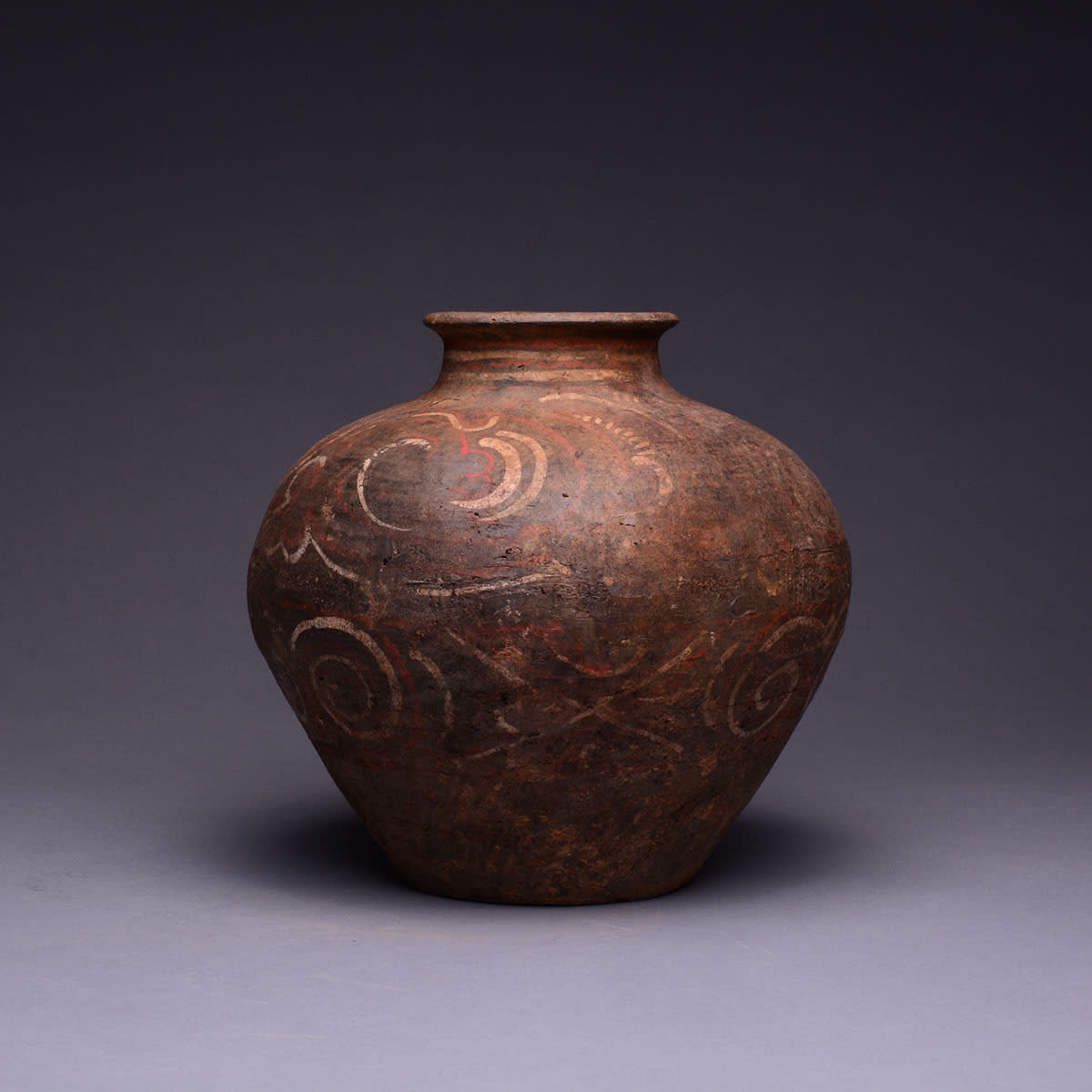Western Han Painted Terracotta Food Storage Vessel, 206 BCE - 9 CE
Painted Terracotta
height 20.3 cm
height 8 in
height 8 in
H.625
Further images
The overextension of the labor force during the Qin Dynasty would result in a popular uprising against the empire. In 206 B.C., Liu Bang, a Qin official, led an army...
The overextension of the labor force during the Qin Dynasty would result in a popular uprising against the empire. In 206 B.C., Liu Bang, a Qin official, led an army composed of peasants and some lower nobility to victory and established his own Dynasty in place, the Han. However, unlike the Qin, the Han would unify China and rule virtually uncontested for over four hundred years. It is during this time that much of what is now considered to be Chinese culture was first actualized. The bureaucracy started under the Qin was now firmly established. The vast lands of China were now under the firm grip of a central authority. Confucianism became the state ideology although the worship of Taoist deity remained widespread, both among the peasants and the aristocracy. Ancient histories and texts were analyzed and rewritten to be more objective while new legendary myths and cultural epics were transcribed.
The Han era can also be characterized as one of the greatest artistic outpourings in Chinese history, easily on par with the glories of their Western contemporaries, Greece and Rome. Wealth pouring into China from trade along the Silk Road initiated a period of unprecedented luxury. Stunning bronze vessels were created, decorated with elegant inlaid gold and silver motifs. Jade carvings reached a new level of technical brilliance. But perhaps the artistic revival of the Han Dynasty is nowhere better represented than in their sculptures and vessels that were interred with deceased nobles. Called mingqi, literally meaning “spirit articles,” these works depicted a vast array of subject, from warriors and horses to ovens and livestock, which were buried alongside the dead for use in the next world, reflecting the Chinese belief that the afterlife was an extension of our earthy existence. Thus, quite logically, the things we require to sustain and nurture our bodies in this life would be just as necessary in our next life.
The extensive polychrome painting that decorates the body of this vessel, depicting swirling foliate and abstract motifs, is quite rare. Seldom do more than traces of pigments survive in tact. Here, designs rendered in red and white are easily discerned against the dull gray hue of the fired terracotta. Bands highlight the low neck, accentuating the join of the neck and body. This food storage container was found interred alongside a deceased nobility or elite member of the Han social hierarchy. During the Han Dynasty, it was believed that the afterlife was an extension of our earthly existence. Thus, logically, if we require food and drink to nourish our bodies on earth, we require the same to nourish our souls in the next world. Although these vessels remain empty today, they once held grains or other substances meant for consumption in the afterlife. A symbol for the bountiful pleasures of life, for ceremonial feasting and celebrations, this container would have represented the joys to be experienced in the afterlife and the feasts and celebrations yet to come. Today, this vessel is not only a gorgeous work of art, treasured for its history and rarity; but also a stunning reminder of the richness and luxury of the Han Dynasty, both in this world and the next.
The Han era can also be characterized as one of the greatest artistic outpourings in Chinese history, easily on par with the glories of their Western contemporaries, Greece and Rome. Wealth pouring into China from trade along the Silk Road initiated a period of unprecedented luxury. Stunning bronze vessels were created, decorated with elegant inlaid gold and silver motifs. Jade carvings reached a new level of technical brilliance. But perhaps the artistic revival of the Han Dynasty is nowhere better represented than in their sculptures and vessels that were interred with deceased nobles. Called mingqi, literally meaning “spirit articles,” these works depicted a vast array of subject, from warriors and horses to ovens and livestock, which were buried alongside the dead for use in the next world, reflecting the Chinese belief that the afterlife was an extension of our earthy existence. Thus, quite logically, the things we require to sustain and nurture our bodies in this life would be just as necessary in our next life.
The extensive polychrome painting that decorates the body of this vessel, depicting swirling foliate and abstract motifs, is quite rare. Seldom do more than traces of pigments survive in tact. Here, designs rendered in red and white are easily discerned against the dull gray hue of the fired terracotta. Bands highlight the low neck, accentuating the join of the neck and body. This food storage container was found interred alongside a deceased nobility or elite member of the Han social hierarchy. During the Han Dynasty, it was believed that the afterlife was an extension of our earthly existence. Thus, logically, if we require food and drink to nourish our bodies on earth, we require the same to nourish our souls in the next world. Although these vessels remain empty today, they once held grains or other substances meant for consumption in the afterlife. A symbol for the bountiful pleasures of life, for ceremonial feasting and celebrations, this container would have represented the joys to be experienced in the afterlife and the feasts and celebrations yet to come. Today, this vessel is not only a gorgeous work of art, treasured for its history and rarity; but also a stunning reminder of the richness and luxury of the Han Dynasty, both in this world and the next.







